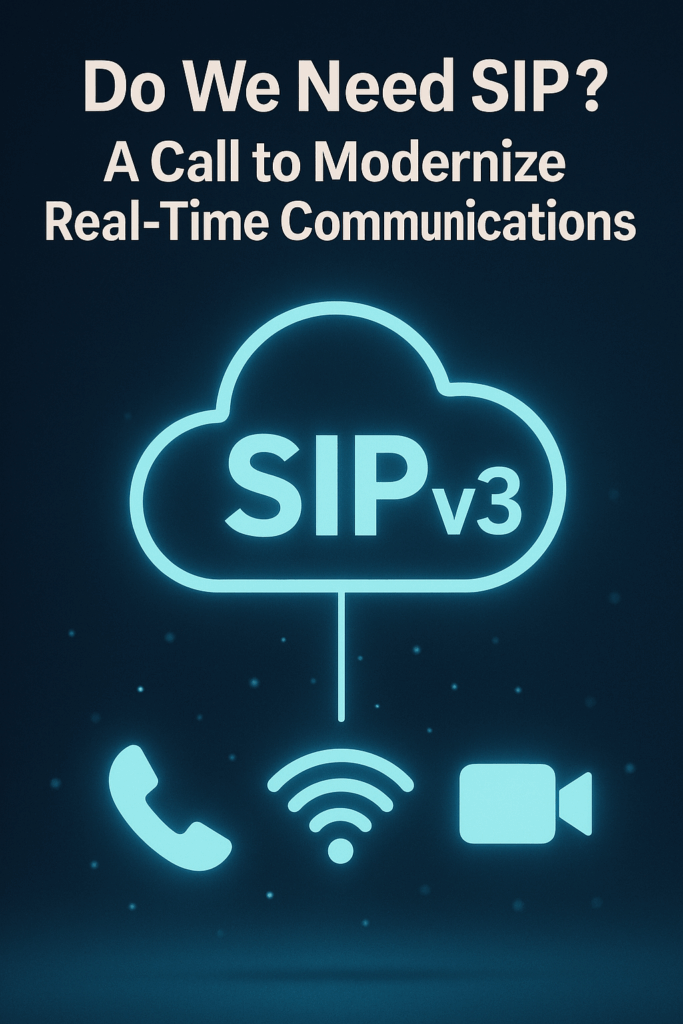
SIP (Session Initiation Protocol) has been the backbone of VoIP for over 20 years. Simple, text-based, and flexible, it became the de facto standard for connecting people across the globe.
But SIP was designed in the late 1990s.
And the world has changed.
The networks we use, the devices we rely on, and the security expectations we have today were unimaginable when SIP was born.
So… is SIP showing its age?
The Limitations of SIP Today
🔎 Heavy, Verbose Text-Based Design
SIP’s text-based format is great for humans, but it’s inefficient. Mobile and IoT networks demand compact, binary protocols that minimize bandwidth and processing overhead.
🔐 Security Pain Points
SIP was built before encryption was the norm. We’ve patched it with TLS and SRTP, but authentication (digest auth) remains weak. Modern identity models like OAuth2 and JWT are missing from SIP’s DNA.
🌐 Poor NAT & Mobility Handling
NAT traversal wasn’t part of SIP’s original design. STUN, TURN, ICE, and SBCs are all after-the-fact solutions. Tying identities to IP addresses makes roaming and mobility complex.
🧩 Too Many Extensions, Fragmentation
Over time, SIP has become a kitchen sink of extensions. Different vendors support different subsets, leading to messy interoperability.
🏗 State Management is Tricky
Dialogs, transactions, and error recovery are stateful but fragile. Distributed systems suffer from mid-dialog failovers and recovery gaps.
🚀 Inefficient for IoT & 5G
Modern networks prioritize low-latency and efficiency. SIP’s overhead doesn’t fit well into constrained, high-performance environments.
🕸 Limited Web-Native Compatibility
Browsers can’t speak SIP natively. WebRTC had to fill that gap, sidelining SIP in the process.
🎛 QoS & Network Control Gaps
SIP can negotiate QoS tags, but enforcement is left to the network. Real-time visibility and control are lacking.
What Could SIP v3 Look Like?
Instead of replacing SIP, what if we evolved it for the modern age?
1. Binary & Compact
Adopt binary encoding (like HTTP/3 & QUIC) for efficiency, while keeping human-readable debug modes.
2. Security by Default
End-to-end encryption as a baseline. Support modern identity/auth methods (JWT, OAuth2, DID).
3. NAT & Mobility First-Class
Native ICE, dynamic IP handling, and peer-to-peer routing models as core features.
4. Simplified Extensions & Modular Design
A small, mandatory core protocol with optional, well-scoped extension modules.
5. Web & Cloud Integration
Seamless compatibility with HTTP/3, WebRTC, and cloud-native scaling (stateless signaling, sharding).
6. Built-in Observability
Standardized logs, telemetry hooks, and real-time diagnostics—no more relying on packet captures alone.
7. Blockchain Support
Imagine for a moment a decentralized UC ecosystem:
- Decentralized Identities (DIDs) replace centralized registrars.
- Distributed SIP Registries on blockchain ensure global reach and tamper-proof records.
- Smart Contracts automate peering, fraud prevention, and even QoS marketplaces.
- Immutable CDRs for transparent billing and audit trails.
Decentralization offers resilience, global interoperability, and reduces reliance on monolithic providers.
Why Now?
- 5G is redefining mobile communications.
- Cloud-native UC is the new normal.
- WebRTC is bypassing SIP where SIP failed to evolve.
- Security & privacy are non-negotiable.
The VoIP industry stands at a crossroads:
Patch an aging protocol, or evolve it to meet the demands of the next decade.
Closing Thought:
“SIP powered the first revolution in global voice and video communications. The next revolution demands a protocol that’s just as open, but ready for the realities of today’s networks. Is it time for SIP v3?”
What Do You Think?
Do we need SIP v3? Should we modernize SIP, or is the industry moving beyond it?
Let’s start the conversation.
Be First to Comment